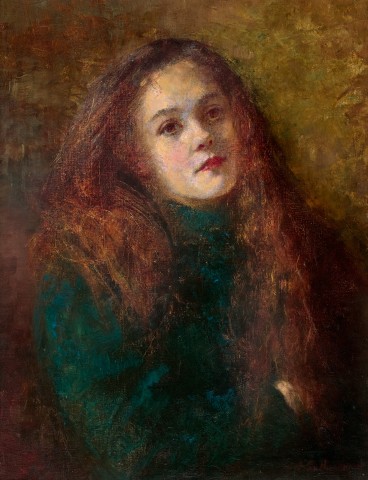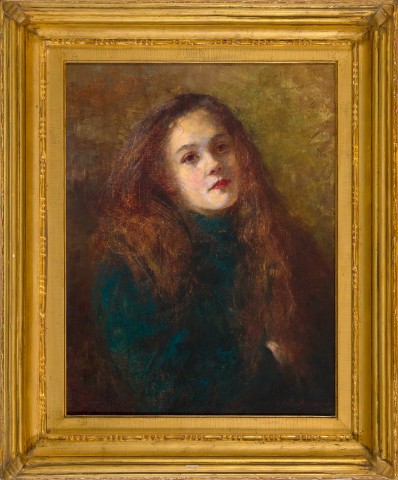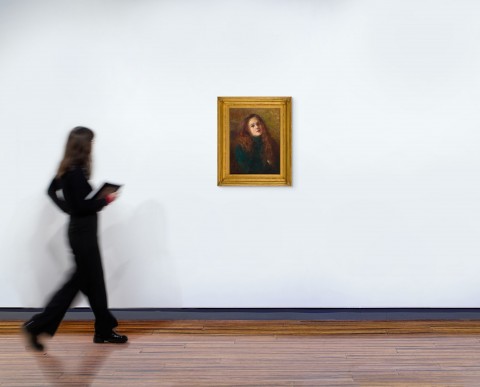PORTRAIT OF THE ARTIST’S COUSIN, c. 1895
JANE SUTHERLAND
oil on canvas
56.0 x 43.5 cm
signed lower right: J. Sutherland
Brenda Sutherland, Melbourne
Christie's, Sydney, 6 October 1976, lot 189 (as 'Portrait of Brenda Sutherland, Cousin of the Artist')
Private collection
Leonard Joel, Melbourne, 11 May 1977, lot 240A (as 'Portrait of Brenda Sutherland, Cousin of the Artist')
Private collection, Melbourne
Deutscher Fine Art, Melbourne
Private collection, Melbourne, acquired from the above in 1993
Sutherland, The Victorian College of the Arts Gallery, Melbourne, 8 – 30 September 1977, cat. 12 (as 'Portrait')
A selection of Nineteenth and Twentieth Century Australian Art, Deutscher Fine Art, Melbourne, 24 May – 9 June 1989, cat. 18 (as '(The artist's cousin)')
A Century of Australian Women Artists 1840s – 1940s, Deutscher Fine Art, Melbourne, 4 June – 3 July 1993, cat. 30
Hammond, V., A Century of Australian Women Artists 1840s – 1940s, Deutscher Fine Art, Melbourne, 1993, cat. 30, p. 53 (illus., as '(The artist's cousin)')
This striking portrait of a young cousin is a compelling example of the art of Jane Sutherland, one of the leading women artists working in Melbourne in the later nineteenth century. Together with friends and colleagues including Clara Southern, Jane Price and May Vale, Sutherland was a vocal and visible advocate for the participation of women in creative fields in the years leading up to (white) women’s national suffrage, granted in 1902.
Sutherland had arrived in Melbourne as a teenager with her parents, numerous siblings and soon, an extended family of aunts, uncles and cousins. The family were liberal, musical and artistic, and the siblings received their earliest art lessons and encouragement from their father George. In 1871, Sutherland commenced formal artistic training at the recently formed National Gallery School the following year. Over a fourteen-year period, her teachers included Thomas Clark, Eugene von Guérard, George Folingsby and Frederick McCubbin. Commended as a student, Sutherland exhibited regularly with local artist groups from the later 1870s. In 1888 she and her friend Clara Southern were among the first to established a studio in the Grosvenor Chambers on Collins Street: by the following year, it was reported that ‘Miss Sutherland is one of the busiest lady artists in Melbourne, as, in addition to her painting, she has several pupils, whom she receives individually or in classes, giving close attention to drawing, as the absolutely necessary groundwork.’1
Sutherland was an active and accomplished participant in Melbourne’s artistic circles: the Grosvenor Chambers had swiftly become a hub for eager artists, with fellow tenants including Roberts, Price Charles Conder and Louis Abrahams. The Sutherland family’s interest in bushwalking corresponded with the younger generation of artists’ increasing interest in plein air painting; from the mid-1880s, Sutherland joined with fellow artists Roberts, Frederick McCubbin, Walter Withers and others on sketching trips around Melbourne. Being female, however, protocols limited the camping that she was able to undertake.
It is not surprising that women and children form the majority of subjects depicted in Sutherland and her female contemporaries’ landscapes, as in Sutherland’s The mushroom gatherers, c.1895 and Field naturalists, c.1896 (both in the collection of the National Gallery of Victoria). Sutherland’s extended family provide a rich source of material for her watercolours, oil paintings and increasingly, after she suffered a debilitating stroke in 1900, her pastels. This portrait is believed to depict her cousin Brenda, who graduated with a Bachelor of Science from the University of Melbourne, and was awarded a coveted travel scholarship to further her study in Canada and the United States.2 Returning to Melbourne she converted her father’s boys’ school Carlton College into a College of Domestic Economy, a field that Brenda advocated over many years as a profession and career for women.3 It has also been suggested that this young woman, with her red tresses reflecting their Scottish ancestry, may depict Brenda’s elder sister Sheila, who opened the Melbourne Book Club in Collins Street in 1918: a painting titled Sheila was exhibited in the Victorian Artists’ Society winter exhibition in 1890.4
1. ‘Miss Jane Sutherland’ Table Talk, 2 Aug. 1889, p. 7
2. ‘Scientist wins distinction’, The Herald, 11 July, 1916, p. 5
3. ‘Domestic arts neglected’, The Herald, 28 May 1918, p. 4
4. Victoria Hammond, A Century of Australian Women Artists 1840s–1940s, Deutscher Fine Art, Melbourne 1993, p. 53
ALISA BUNBURY


